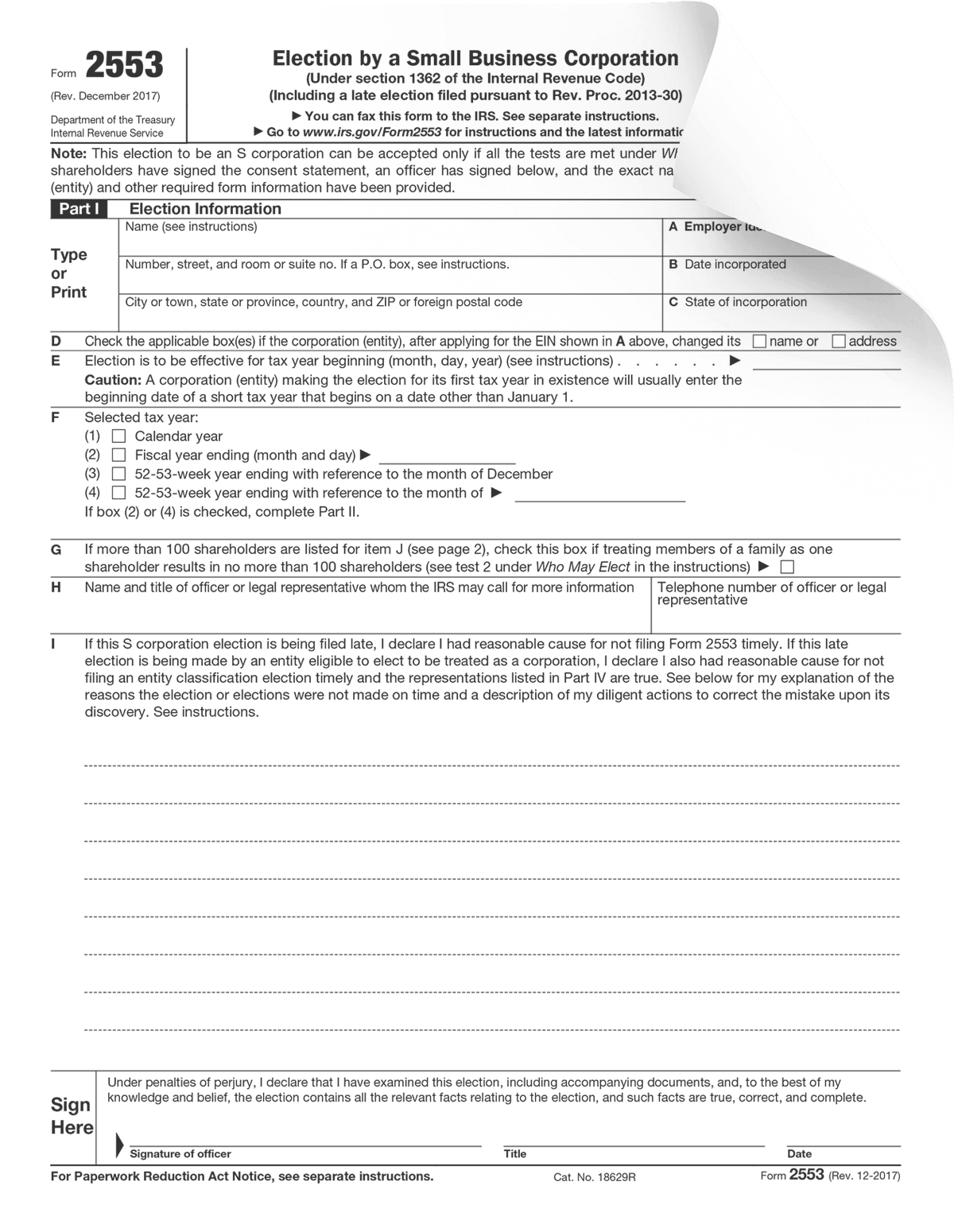What is the official name of Form 2553 and what is its purpose?
The official name of IRS Form 2553 is “Election by a Small Business Corporation.” Its primary purpose is to allow a qualifying small business corporation to elect S Corporation status for tax purposes. By making this election, the business elects pass-through taxation, allowing income, losses, deductions, and credits to flow directly to shareholders. This structure helps avoid the double taxation that C Corporations typically face. As a result, this election can significantly help businesses reduce their overall tax liability, particularly when it comes to self-employment taxes and federal income taxes on corporate profits.
Why would you want to elect S Corporation status?
Electing S Corporation status offers several key tax advantages for small business owners:
1. Avoid Double Taxation
In contrast to a C Corporation, which pays taxes on its profits while shareholders also pay taxes on dividends, an S Corporation avoids double taxation, making it a more tax-efficient option. Shareholders pay taxes on the income only once at the individual level.
2. Minimize Self-Employment Taxes
In a sole proprietorship or partnership, all business income is subject to self-employment taxes (Social Security and Medicare). However, S Corporation shareholders can pay themselves a reasonable salary while receiving the remaining profits as distributions, which are not subject to self-employment taxes. As a result, this structure can significantly reduce the total tax burden.
3. Pass-Through Taxation
As a pass-through entity, an S Corporation transfers its income, deductions, and credits directly to shareholders, who report them on their personal tax returns and pay taxes at individual rates. This simplifies the process and may offer additional tax savings depending on individual tax situations.
4. Potential Savings on Medicare Taxes
By strategically structuring compensation between salary and distributions, S Corporation owners can not only reduce the amount of income subject to Medicare taxes but also maximize their overall tax savings.
Is your business eligible for S Corporation election?

Not all businesses qualify for S Corporation status under IRS rules. Before filing a fillable Form 2553 and proceeding with this election, a business must first ensure it meets specific eligibility requirements.
Must Be a Domestic Corporation
The business must be a U.S.-based corporation. Foreign corporations are not eligible to elect S Corporation status.
Limited Number of Shareholders
An S Corporation can have no more than 100 shareholders. However, certain family members, such as spouses and direct descendants, may count as a single shareholder for this limit. As a result, family-owned businesses gain added flexibility.
Eligible Shareholders Only
Shareholders must meet specific criteria:
- They must be U.S. citizens or resident aliens. Non-resident aliens cannot be shareholders in an S Corporation.
- Shareholders cannot be other corporations, partnerships, or certain types of trusts. However, specific types of trusts, such as grantor trusts, are allowed as shareholders.
Only One Class of Stock
The business must have only one class of stock, meaning all shares must provide equal rights to distributions and liquidation proceeds. This ensures that all shareholders are treated equally, though voting rights may vary.
Eligible Entity Types
Although small businesses incorporated as C Corporations typically choose S Corporation status, other eligible entities, such as limited liability companies (LLCs), can also elect to be taxed as an S Corporation for tax purposes. On the other hand, partnerships, sole proprietorships, and foreign corporations cannot directly make this election.
Agreement of All Shareholders
To make the election, all shareholders must agree to the S Corporation status. This requires their signatures on a fillable Form 2553 at the time of filing.
By meeting these criteria, your business can qualify to file Form 2553 online and take advantage of the tax benefits associated with S Corporation status. It’s important to ensure that the business remains compliant with these rules to maintain the election in future years.
When and how do you file Form 2553?

If you’ve decided that S Corporation status is the right fit for you, you might be wondering what’s next? How exactly do you file Form 2553 instructions and when is the appropriate time to do so? Knowing the deadlines and understanding the filing process helps avoid complications that could affect your tax situation.
When Should You File?
New Corporations: If your corporation is newly formed, you must file Form 2553 instructions no later than 2 months and 15 days after the start of your business’s tax year, which is typically its incorporation date. By adhering to this deadline, you ensure that the S Corporation election applies for that tax year, preventing any unnecessary tax complications.
Existing Corporations or LLCs: On the other hand, if your business is already operating as a C Corporation or an LLC, Form 2553 instructions require filing no later than 2 months and 15 days into the tax year for the election to take effect in the current tax year. However, if you miss this critical window, the S Corporation status will not apply until the next tax year unless you qualify for late election relief. Fortunately, the IRS may grant late election relief if the business can demonstrate a reasonable cause for the delay and meets specific criteria. Nevertheless, this process requires additional steps and approval, so it is essential to plan ahead to avoid unnecessary delays or complications.
Failing to meet the deadline means the corporation will remain a C Corporation for the current tax year, resulting in double taxation—once at the corporate level and again on dividends paid to shareholders.
Step-by-Step Guide to Filing a Fillable Form 2553:
Filing a fillable Form 2553 involves several important steps:
1. Download the Form: Download IRS Form 2553 from the IRS website or obtain it through an authorized tax professional.
2. Complete Basic Information: To begin, fill in your business’s essential details, including the corporation’s name, EIN (Employer Identification Number), date of incorporation, and tax year. Ensuring accuracy at this stage helps prevent delays or issues with your Form 2553 filing.
3. Specify Election Date: On Part 1, Section E, enter the effective date of your S Corporation election. If you’re filing within the first 2 months and 15 days of the tax year, then in most cases, the start date of the tax year will serve as the effective date for your S Corporation election. Filing on time ensures your election takes effect without unnecessary delays.
4. List Shareholder Information: Each shareholder must provide their name, address, and Social Security Number (or EIN for eligible entities). All shareholders must agree to and sign the form.
5. Indicate Fiscal Year (if applicable): While most businesses operate on a calendar year basis, some may choose to use a fiscal year instead. If your business follows a fiscal year, you will need to complete Part 2 of Form 2553 and provide a justification for this choice. Ensuring proper documentation helps prevent potential processing delays.
6. Submit the Form: Once completed, submit the form to the IRS via mail or fax. The IRS will review your application and notify you of its approval or rejection.
Try to Avoid These Common Mistakes:
I. Missing Deadlines: Filing IRS Form 2553 late is one of the most common mistakes. Ensure you track the filing window closely, especially if you’re a new business or converting from another tax structure.
II. Incorrect Shareholder Information: All shareholders must be listed and sign the form. Missing or incorrect information can result in rejection of your election.
III. Multiple Classes of Stock: Ensure that your business only has one class of stock before filing. Having multiple classes will disqualify you from S Corporation status.
IV. Not Following State Requirements: Some states don’t recognize S Corporation status, or they have additional requirements. Always check state-specific rules when making the election.
As of 2024 three states do not recognize S Corporation status:
| New Hampshire | Tennessee | Texas |
Some other states recognize S Corporation status but impose additional taxes or require separate elections at the state level. For example:
| California | New York | Illinois | New Jersey |
| Recognizes S Corporation status but imposes a 1.5% franchise tax on net income, with a minimum tax. | Requires a separate S Corporation election for state tax purposes. | Recognizes S Corporations but levies a personal property replacement tax. | S Corporations must make a separate state election and are subject to additional state taxes. |
Let FormPros Help!
With FormPros, filing Form 2553 to elect S Corporation status is quick and easy. Take advantage of expert assistance to ensure accuracy and compliance. Whether you’re filing Form 2553, handling personal taxes with Form 1040, or managing contractor payments with 1099-MISC and W-9 forms, we’ve got you covered. Don’t let paperwork slow you down—get all your essential tax forms done in one place, hassle-free. Start filing today and focus on growing your business!
Form 2553 FAQs
-
How long does it take for the IRS to process Form 2553?
The IRS typically takes 60 days to process Form 2553. You will receive a confirmation letter once approved.
-
Can a single-member LLC file Form 2553?
Yes, a single-member LLC can file Form 2553 to elect S Corporation status for tax purposes.
-
What happens if the IRS rejects my Form 2553?
If Form 2553 is rejected, the business will remain a C Corporation (or default LLC tax status), and you may need to reapply or seek late election relief.
-
Is there a fee to file Form 2553?
No, the IRS does not charge a fee to file Form 2553.
-
Can I revoke my S Corporation election?
Yes, you can revoke your S Corporation status by filing Form 1120S. This must be done by March 15th of the tax year to be effective for that year.
-
What is the reasonable compensation requirement for S Corporation shareholders?
Shareholders must receive reasonable compensation for their work, meaning wages that are in line with market rates for similar jobs.
-
Does filing Form 2553 affect state taxes?
Yes, some states may require additional forms or have separate rules regarding S Corporation elections. Always check your state’s requirements.
-
Can foreign individuals own shares in an S Corporation?
No, only U.S. citizens or resident aliens can be shareholders in an S Corporation.
-
What if my business misses the 2 months and 15 days deadline?
You may apply for late election relief if you can demonstrate reasonable cause for missing the deadline, and the IRS may still approve your election.
-
Does electing S Corporation status affect fringe benefits?
Yes, some fringe benefits like health insurance may be treated differently for S Corporation owners, potentially resulting in additional taxes for certain benefits.
-
Can my S Corporation have multiple fiscal years?
Most S Corporations are required to use a calendar year, unless you get special approval from the IRS for a different fiscal year.
-
What are the ongoing filing requirements for an S Corporation?
An S Corporation must file Form 1120S annually and provide Schedule K-1 forms to each shareholder for their personal tax returns.
-
Does electing S Corporation status affect payroll taxes?
Yes, you must pay payroll taxes on the salaries of shareholders who work in the business, but not on their distributions.
-
Can S Corporation status impact eligibility for certain tax credits?
Yes, some tax credits available to C Corporations may not apply to S Corporations. Consult a tax professional to ensure you’re eligible for the credits you seek.
-
How do I change from an S Corporation back to a C Corporation?
You must file a formal revocation with the IRS, and it requires the consent of more than 50% of the shareholders.






